AP State Syllabus AP Board 9th Class Biology Important Questions Chapter 7 Animal Behaviour.
AP State Syllabus 9th Class Biology Important Questions 7th Lesson Animal Behaviour
9th Class Biology 7th Lesson Animal Behaviour 1 Mark Important Questions and Answers
Question 1.
What are the expressions of animals to protect themselves from predators?
Answer:
Hissing of snakes, barking of dogs, stiffing of nailed hair of hedgehog (mullapandi), bad flavour from skin of tasmanian devil etc., are all the expressions to protect them¬selves from predators.
Question 2.
Why fish do not need to learn how to swim?
Answer:
Swimming is an instinct behaviour to fish. Hence they don’t need to learn how to swim.
![]()
Question 3.
How can butterfly get to know about nectar?
Answer:
Butterfly gets to know about the nectar instinctively.
Question 4.
Who does teach a bird to make a nest?
Answer:
There is no need to teach the bird to make it’s nest, because it is an instinct behaviour.
Question 5.
Give two examples of reflexes.
Answer:
- Kicking out when the doctor taps your knee with a small hammer.
- Sudden closing of eyes when a bright light is flashed on your face.
Question 6.
Give one example of imprinting from your surroundings.
Answer:
Salmon bird goes back to its home stream to spawn.
![]()
Question 7.
Give one example for conditioning.
Answer:
A tiger in a circus learns to stand up on a chair and jump through a hop to receive a food treat.
Question 8.
Name the branch of zoology that deals with scientific and objective study of animal behaviour.
Answer:
Ethology.
Question 9.
Give one example for imprinting behaviour.
Answer:
Ducklings follow the first moving object they meet after hatching and treat it as their mother.
Question 10.
Give one example of instinctive behaviour.
Answer:
Building a nest by birds/climbing trees by monkeys/swimming of fish in a lake.
Question 11.
Name the scientist who studied animal behaviour – imprinting.
Answer:
Konard Lorenz.
Question 12.
What are the other behaviours we find in animals and give examples?
Answer:
Animals show the feelings like happiness, threat, fear, anger, sadness etc…..
Eg: After returning from fields in the evening cow licks its calf. It reflects it’s affection towards its body.
![]()
Question 13.
How Tasmanian Devil protects itself from enemies?
Answer:
By spraying bad odour through it’s body.
Question 14.
What is imitation?
Answer:
People often imitate each other. This can help them to learn new and useful skills. It may also lead them to certain unwanted behaviours like drinking, smoking etc…
Question 15.
How do cockroaches differentiate light and dark?
Answer:
Cockroaches have eyes that are adapted to sense the difference between daylight and dark. Their eyes have cells that perceive light.
Question 16.
What is a pheramone?
Answer:
It is secreted or excreted chemical that triggers a social response in the members of same species.
Eg : ants, honey bees…
Question 17.
What are primates?
Answer:
The group of mammals that includes humans and monkeys.
![]()
Question 18.
Name the animal on which Ivan Pavlov done his experiments.
Answer:
Dog.
Question 19.
Give two examples of conditioning.
Answer:
- Electronic fence stop grazing animals straying.
- Children come out of the classroom after hearing the school bell.
Question 20.
What is special about Beaver?
Answer:
Beaver is a mammal which lives in South America, builds dams across water streams. Stagnated water is the living home for Beavers family.
Question 21.
Give names of scientists of Ethology.
Answer:
- Nikolas Tinbergen
- Konard Lorenz
- Karlvon Frisch
9th Class Biology 7th Lesson Animal Behaviour 2 Marks Important Questions and Answers
Question 1.
What do you mean by animal behaviour? What it indicates?
Answer:
- Animal behaviour is the scientific study of the wild and wonderful ways in which animals interact with either, with other living beings and with the environment.
- It explores how animals relate to their physical environment as well as to other organisms.
- It also includes topics such as how animals find and defend resources, avoid predators, choose mates, reproduce and care for their young.
![]()
Question 2.
What are the uses and loses of imitation in human behaviour?
Answer:
- Imitation can help us learn something new and useful, such as new skill in lessons, sports or at work.
- Imitation also leads us to show less useful or harmful behaviour.
- For example, young people may start smoking, drinking alcohol or taking drugs as a result of copying each other to fit in.
- But it is very dangerous for our health.
Question 3.
How conditioning can be used to change the behaviour of people by advertisers?
Answer:
- Advertisers are very skilled in changing the behaviour of people.
- They use pictures of their products which make them look glamorous or exciting, often by using famous actors or sportspeople.
- By associating the product with attractive images the advertisers are trying to set up a conditioned response to their product.
- People will respond positively and buy the product.
Question 4.
Explain about tagging.
Answer:
- Like birds some other animals also migrate over large distances to find food or nesting sites.
- Animals can be tagged by attaching tracking devices to them.
- Tagging lets the scientists follow the journeys the animals make.
Question 5.
Write the process of hiding food by Scrubjay bird.
Answer:
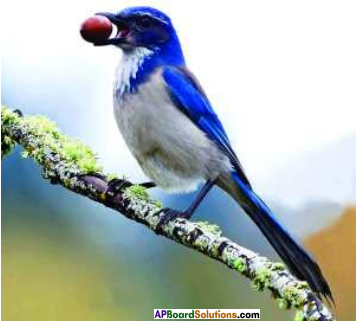
- A bird called scrubjay hides its food.
- An experiment proved that a scrubjay had hidden its food in presence of another bird.
- After some time it was found that the other bird had stolen it by fixing a plan.
Question 6.
Write about a mammal Beaver, which lives in North America.
Answer:
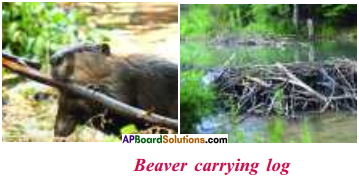
- Beaver a mammal which lives in North America builds dams across water streams.
- Beaver cut big trees by its sharp teeth to fell the trees across the stream.
- Then the beaver constructed nearly four feet wall by using twigs, stones and mud.
- Stagnated water is the living home for beavers family.
Question 7.
Give two examples for reflexes.
Answer:
- Closing of the eyes when there is anything threatening the eye.
- The contraction of pupil when bright light enters eye.
- Withdrawing our hand when we touch hot objects.
- We sneeze when something enter our nose.
- We cough when we inhale dust etc.
![]()
Question 8.
How squirrels cheat others?
Answer:
Squirrels hide their food in an interesting way. They always behave in such a manner that somebody is trying to steal their food. In order to misguide others they dig holes in many places and heap leaves to cover them. Most of the holes do not contain food. In this way they cheat others by making believe that these holes contain food.
Question 9.
How beetle protects itself from enemies?
Answer:
Beetle (or) Bombardie Beetle has two chemicals hydroquinone and hydrogen peroxide stored in it’s body. Whenever the beetle feels threatened these chemicals mix with some special enzymes and that heat up the liquids which gives bad smell from it’s body.
Question 10.
What are the amazing features of intelligence of Dolphins?
Answer:
Dolphins have great logical thinking power they could understand a code language if they are trained by practice. The trained dolphins bring ball from the tub and throw it again into the same tub. They remember the names by short whistle.
9th Class Biology 7th Lesson Animal Behaviour 4 Marks Important Questions and Answers
Question 1.
Write about the experiment conducted by Ivan Pavlov on conditioning.
Answer:

- Ivan Pavlov (1849 to 1936) was a Russian Scientist who has investigated conditioning.
- He discovered that dogs produced extra saliva when they were offered food.
- Pavlov noticed that they also did the same when the person who fed them came into the room, even if the person had not brought any food.
- Pavlov went on to ring a bell at the start of feeding time, and eventually, the dogs produced extra saliva when they heard the bell, before any food was brought.
- A dog salivating when it hears a bell is not a natural response.
- They would not do this without being conditioned to do so.
- The behaviour has been learned. It is called a conditioned response.
Question 2.
Describe the process of hiding food by squirrel.
Answer:
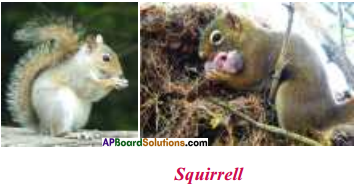
- Squirrels hide their food in a fascinating way.
- They always behave in such a man¬ner that somebody is trying to steal their food.
- In order to misguide others they dig holes in many places and heap leaves, starch etc., to cover them.
- Sometimes most of the holes does not contain any food.
- In this way they cheat others to make believe that these holes contain food.
Question 3.
How wasp (bee) construct hive and how it collects food?
Answer:

- Wasp is an intelligent bee which builds its home keeping in view its future needs.
- Wasp builds its hive on the walls by using mud.
- They select suitable mud for constructing its hive.
- After constructing its hive they search for food.
- They collect food material by injecting its venom (usually other larva) and kept in it its hive.
- Wasp lay its eggs on the food material, which it used as food for larva of wasps.
Question 4.
Who experimentally proved that Dolphins have logical thinking power? Write about the experiments.
Answer:

- Hermon proved that Dolphins have great logical thinking power.
- Hermon studied four bottle nose Dolphins at Kavalo Basin mammal Laboratory of Hawai Islands.
- He named four Dolphins as Akkikomoi, Phoenix, Allen and Hippo.
- Hermon could understand by his study that Dolphins can remember their names and understand a code language if they are trained by practice.
- For example, the closed fist shows a tub, raised arms show a ball and one hand raised tells ‘bring here’.
- If we show the above actions in a sequence, the Dolphins would bring the ball from the tub, if we reverse the actions they throw the ball into the tub.
- If a Dolphin of particular whistle is called all the Dolphins stare at, while the par¬ticular one comes to us.
Question 5.
Describe the wonder behaviour of an African parrot Alex.
Answer:
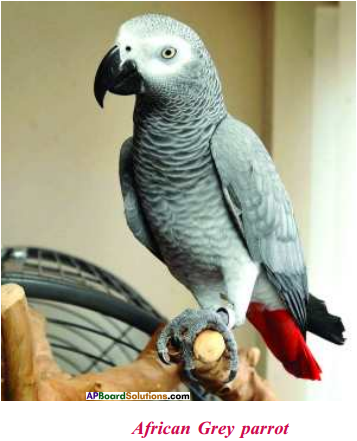
- In 1977, Ervin Pepperberg brought a parrot and trained it.
- Slowly he made it learn more than 100 words.
- He then arranged the words in a such a way that Alex can frame its own sentences.
- After some days, he showed Alex one yellow bowl and another yellow dish and it recognised similarities and differences between them.
- Alex even tried to teach other parrots of its group.
- Alex called apple as ‘Bannery’ because it tastes like a banana and look like a big cherry. Naming in this way is a sign of creativity in language.
- Before Alex’s death, it could even learnt up to 7th table.
9th Class Biology 7th Lesson Animal Behaviour Important Questions and Answers
Question 1.
Explain behavioural adaptations of animals using two examples.
Answer:
- Nesting of birds, selecting mates, forming flocks for protection from enemies are some examples for behavioural adaptations in animals.
- Beaver, a mammal which lives in North America builds dams across water streams and catch the fish and feeds it’s family.
![]()
Question 2.
What are the ways to observe the behaviour of animals? Explain any one of them with suitable examples.
Answer:
- Scientists observe the animal behaviour either directly or indirectly.
- Behaviour can be investigated in the field or in the laboratory.
- Scientists spend many hours watching and studying the behaviour of animals. Animals can signal to each other. For example, they may call each other to warn danger. Some of the scientists record and study them to work out what the signals mean.
- Scientists use tagging method to observe bird and animal migration. Animals can be ‘tagged’ by attaching tracking devices to them. This lets scientists follow the journeys the animals make.
Question 3.
What is Tagging? How it is useful to scientists?
Answer:
- Scientists use tagging method to observe bird and animal migration.
- Animals can be “tagged” by attaching tracking devices to them.
- This lets the scientists to follow the journeys the animals make.
Question 4.
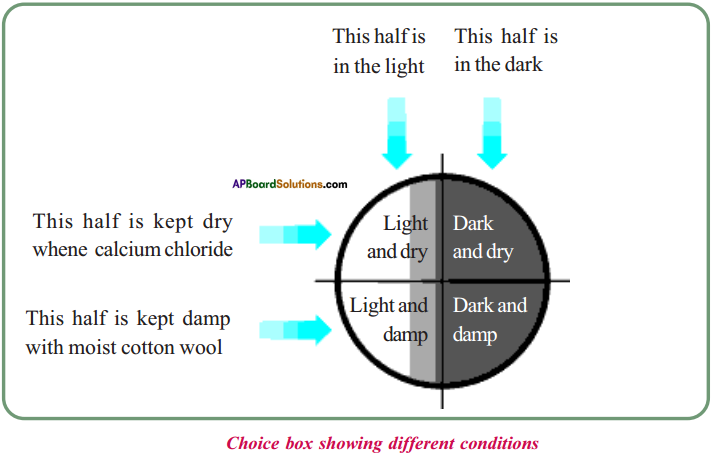
Observe the figure and answer the following questions.
1) In which chamber more cockroaches are there?
2) In which chamber less cockroaches are there?
3) What are the conditions of chamber that live more cockroaches?
4) How the behaviour of cockroaches?
Answer:
- Dark and damp conditions.
- Light and dry chamber.
- Damp and dark condition.
- Cockroaches searched for their favourite conditions and reached the dark damp chamber.
Question 5.
Observe the picture and answer the following.

a) What is the aim of the experiment?
b) Write about the behaviour of cockroaches.
c) Write down the differences of situation provided between two chambers having less and more cockroaches.
d) What will happen if you put rats instead of cockroaches in the above room?
Answer:
a) To study the behaviour of cockroaches.
b) Cockroaches selected their favourite conditioned chamber – dark and damp. In these conditions only cockroaches can survive.
c) The experimental box is divided into a choice of chamber with four different conditions. They are
a) light and dry
(b) light and humid
(c) dark and dry
(d) dark and humid.
Finally the cockroaches reached dark and humid chamber.
d) Rats also choose dark and damp chamber. Because darkness enable them to escape from predators and damp conditions make favour to maintain body temperature.
![]()
Question 6.
Suppose you were a quiz master for biology round in an event. Prepare some questions to ask about “Instinct” and “Imitation” in that event.
Answer:
- Birds fly in the sky – which type of animal behaviour is this?
- Ramu saw some ducklings following a hen. He was amazed to see this. Which type of animal behaviour is this?